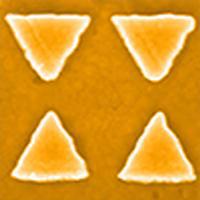当前位置:
X-MOL 学术
›
Photonics Res.
›
论文详情
Our official English website, www.x-mol.net, welcomes your feedback! (Note: you will need to create a separate account there.)
Synergistic effects of electric-field-enhancement and charge-transfer based SERS study in Ag₂S quantum dots/plasmonic bow-tie nanoantenna composite system
Photonics Research ( IF 7.6 ) Pub Date : 2020-03-31 , DOI: 10.1364/prj.383612 Bin Wang , Chen Zhao , Huanyu Lu , Tingting Zou , Subhash C. Singh , Zhi Yu , Chaonan Yao , Xin Zheng , Jun Xing , Yuting Zou , Cunzhu Tong , Weili Yu , Bo Zhao , Chunlei Guo
Photonics Research ( IF 7.6 ) Pub Date : 2020-03-31 , DOI: 10.1364/prj.383612 Bin Wang , Chen Zhao , Huanyu Lu , Tingting Zou , Subhash C. Singh , Zhi Yu , Chaonan Yao , Xin Zheng , Jun Xing , Yuting Zou , Cunzhu Tong , Weili Yu , Bo Zhao , Chunlei Guo

|
Localized surface plasmon resonance (LSPR) of nanostructures and the interfacial charge transfer (CT) of semiconductor materials play essential roles in the study of optical and photoelectronic properties. In this paper, a composite substrate of Ag2S quantum dots (QDs) coated plasmonic Au bowtie nanoantenna (BNA) arrays with a metal–insulator–metal (MIM) configuration was built to study the synergistic effect of LSPR and interfacial CT using surface-enhanced Raman scattering (SERS) in the near-infrared (NIR) region. The Au BNA array structure with a large enhancement of the localized electric field (E-field) strongly enhanced the Raman signal of adsorbed p-aminothiophenol (PATP) probe molecules. Meanwhile, the broad enhanced spectral region was achieved owing to the coupling of LSPR. The as-prepared Au BNA array structure facilitated enhancements of the excitation as well as the emission of Raman signal simultaneously, which was established by finite-difference time-domain simulation. Moreover, Ag2S semiconductor QDs were introduced into the BNA/PATP system to further enhance Raman signals, which benefited from the interfacial CT resonance in the BNA/Ag2S-QDs/PATP system. As a result, the Raman signals of PATP in the BNA/Ag2S-QDs/PATP system were strongly enhanced under 785 nm laser excitation due to the synergistic effect of E-field enhancement and interfacial CT. Furthermore, the SERS polarization dependence effects of the BNA/Ag2S-QDs/PATP system were also investigated. The SERS spectra indicated that the polarization dependence of the substrate increased with decreasing polarization angles (θpola) of excitation from p-polarized (θpola=90°) excitation to s-polarized (θpola=0°) excitation. This study provides a strategy using the synergistic effect of interfacial CT and E-field enhancement for SERS applications and provides a guidance for the development of SERS study on semiconductor QD-based plasmonic substrates, and can be further extended to other material-nanostructure systems for various optoelectronic and sensing applications.
中文翻译:

基于电场增强和电荷转移的 SERS 研究在 Ag2S 量子点/等离子体领结纳米天线复合系统中的协同效应
纳米结构的局域表面等离子体共振 (LSPR) 和半导体材料的界面电荷转移 (CT) 在光学和光电特性的研究中起着至关重要的作用。在本文中,构建了具有金属 - 绝缘体 - 金属(MIM)配置的 Ag2S 量子点(QDs)涂覆等离子体 Au 蝴蝶结纳米天线(BNA)阵列的复合基板,以使用表面增强技术研究 LSPR 和界面 CT 的协同效应。近红外 (NIR) 区域的拉曼散射 (SERS)。局部电场(E场)大幅增强的Au BNA阵列结构强烈增强了吸附对氨基苯硫酚(PATP)探针分子的拉曼信号。同时,由于LSPR的耦合,实现了宽广的增强光谱区域。所制备的 Au BNA 阵列结构有助于同时增强激发和拉曼信号的发射,这是通过有限差分时域模拟建立的。此外,将 Ag2S 半导体量子点引入 BNA/PATP 系统以进一步增强拉曼信号,这得益于 BNA/Ag2S-QDs/PATP 系统中的界面 CT 共振。因此,由于电场增强和界面 CT 的协同作用,BNA/Ag2S-QDs/PATP 系统中 PATP 的拉曼信号在 785 nm 激光激发下强烈增强。此外,还研究了 BNA/Ag2S-QDs/PATP 系统的 SERS 极化依赖性效应。SERS 光谱表明基板的偏振相关性随着从 p 偏振 (θpola=90°) 激发到 s 偏振 (θpola=0°) 激发的激发偏振角 (θpola) 的减小而增加。该研究为SERS应用提供了一种利用界面CT和电场增强的协同效应的策略,并为半导体QD基等离子体衬底的SERS研究的发展提供了指导,并可进一步扩展到其他材料-纳米结构系统中各种光电和传感应用。
更新日期:2020-03-31
中文翻译:

基于电场增强和电荷转移的 SERS 研究在 Ag2S 量子点/等离子体领结纳米天线复合系统中的协同效应
纳米结构的局域表面等离子体共振 (LSPR) 和半导体材料的界面电荷转移 (CT) 在光学和光电特性的研究中起着至关重要的作用。在本文中,构建了具有金属 - 绝缘体 - 金属(MIM)配置的 Ag2S 量子点(QDs)涂覆等离子体 Au 蝴蝶结纳米天线(BNA)阵列的复合基板,以使用表面增强技术研究 LSPR 和界面 CT 的协同效应。近红外 (NIR) 区域的拉曼散射 (SERS)。局部电场(E场)大幅增强的Au BNA阵列结构强烈增强了吸附对氨基苯硫酚(PATP)探针分子的拉曼信号。同时,由于LSPR的耦合,实现了宽广的增强光谱区域。所制备的 Au BNA 阵列结构有助于同时增强激发和拉曼信号的发射,这是通过有限差分时域模拟建立的。此外,将 Ag2S 半导体量子点引入 BNA/PATP 系统以进一步增强拉曼信号,这得益于 BNA/Ag2S-QDs/PATP 系统中的界面 CT 共振。因此,由于电场增强和界面 CT 的协同作用,BNA/Ag2S-QDs/PATP 系统中 PATP 的拉曼信号在 785 nm 激光激发下强烈增强。此外,还研究了 BNA/Ag2S-QDs/PATP 系统的 SERS 极化依赖性效应。SERS 光谱表明基板的偏振相关性随着从 p 偏振 (θpola=90°) 激发到 s 偏振 (θpola=0°) 激发的激发偏振角 (θpola) 的减小而增加。该研究为SERS应用提供了一种利用界面CT和电场增强的协同效应的策略,并为半导体QD基等离子体衬底的SERS研究的发展提供了指导,并可进一步扩展到其他材料-纳米结构系统中各种光电和传感应用。



























 京公网安备 11010802027423号
京公网安备 11010802027423号